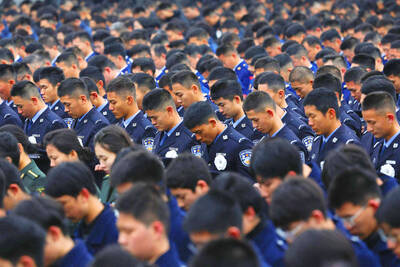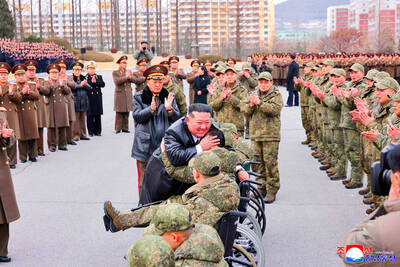A magnitude 7.7 earthquake shook Indonesia’s northwest island of Sumatra early yesterday, prompting a brief tsunami warning and sending panicked residents rushing for higher ground.
There were scattered reports of injuries, but only minor damage in most areas.
The quake struck at 5:15am local time and was centered 205km northwest of the coastal town of Sibolga in Sumatra at a depth of 31km, the US Geological Survey said. It had earlier said the quake measured 7.8.
Indonesia’s Meteorology and Geophysics Agency and the Pacific Tsunami Warning Center in Honolulu issued tsunami warnings following the quake, but lifted them two hours later.
A hospital on the island of Simeulue off the coast of Sumatra admitted 17 people for treatment of injuries sustained in the quake, including four in critical condition, said Captain Ajas Siagian, a deputy police chief for the area.
Abdul Karim, a government spokesman in Simeulue, said dozens of houses collapsed or were damaged in Teupah Selatan village. He said no larger buildings were reported damaged, but electricity had been knocked out on the island.
“We are still collecting reports of damages and injuries ... but the situation has returned to normal and people are going back home,” he said.
Local network Metro TV reported a dormitory for nurses partially collapsed in Aceh Province’s district of Singkil and one woman suffered minor injuries in the rush to get out of the building. It said fires sparked by the quake had burned at least 14 houses in Medan, the capital city of North Sumatra Province.
Electricity was cut in Medan, Banda Aceh, the provincial capital of Aceh and other areas.
Paulus Prihandojo, another seismologist with the meteorology agency, said along with the quake’s relative depth, the epicenter was too far away from the major population centers of Medan and Banda Aceh to cause major damage.
He said areas closer to the epicenter were more sparsely populated and many of the buildings in that area were made of wood, which fares better in earthquakes than brick and cement.
At least five strong aftershocks measuring up to 5.2 were recorded, the meteorology agency said.
People in several cities along the southeastern coast of Sumatra as well as Sinabang on Simeulue island and Gunung Sitoli on nearby Nias island poured into the streets and rushed to higher ground after the quake.
“Rumors about a tsunami panicked villagers living near the beach,” said Eddy Effendi, a resident on Nias island. “They ran away on motorbikes and cars or by climbing the hills. There was panic and chaos everywhere, but I don’t see serious damage or injuries in my village.”
Residents in Sibolga said the shaking lasted more than a minute and utility poles in the area were knocked down.
The quake was felt as far away as the outskirts of Malaysia’s Kuala Lumpur, about 515km away. There were no reports of damage there.

PARLIAMENT CHAOS: Police forcibly removed Brazilian Deputy Glauber Braga after he called the legislation part of a ‘coup offensive’ and occupied the speaker’s chair Brazil’s lower house of Congress early yesterday approved a bill that could slash former Brazilian president Jair Bolsonaro’s prison sentence for plotting a coup, after efforts by a lawmaker to disrupt the proceedings sparked chaos in parliament. Bolsonaro has been serving a 27-year term since last month after his conviction for a scheme to stop Brazilian President Luiz Inacio Lula da Silva from taking office after the 2022 election. Lawmakers had been discussing a bill that would significantly reduce sentences for several crimes, including attempting a coup d’etat — opening up the prospect that Bolsonaro, 70, could have his sentence cut to

China yesterday held a low-key memorial ceremony for the 1937 Nanjing Massacre, with Chinese President Xi Jinping (習近平) not attending, despite a diplomatic crisis between Beijing and Tokyo over Taiwan. Beijing has raged at Tokyo since Japanese Prime Minister Sanae Takaichi last month said that a hypothetical Chinese attack on Taiwan could trigger a military response from Japan. China and Japan have long sparred over their painful history. China consistently reminds its people of the 1937 Nanjing Massacre, in which it says Japanese troops killed 300,000 people in what was then its capital. A post-World War II Allied tribunal put the death toll

‘UNWAVERING ALLIANCE’: The US Department of State said that China’s actions during military drills with Russia were not conducive to regional peace and stability The US on Tuesday criticized China over alleged radar deployments against Japanese military aircraft during a training exercise last week, while Tokyo and Seoul yesterday scrambled jets after Chinese and Russian military aircraft conducted joint patrols near the two countries. The incidents came after Japanese Prime Minister Sanae Takaichi triggered a dispute with Beijing last month with her remarks on how Tokyo might react to a hypothetical Chinese attack on Taiwan. “China’s actions are not conducive to regional peace and stability,” a US Department of State spokesperson said late on Tuesday, referring to the radar incident. “The US-Japan alliance is stronger and more

FALLEN: The nine soldiers who were killed while carrying out combat and engineering tasks in Russia were given the title of Hero of the Democratic People’s Republic of Korea North Korean leader Kim Jong-un attended a welcoming ceremony for an army engineering unit that had returned home after carrying out duties in Russia, North Korean state media KCNA reported on Saturday. In a speech carried by KCNA, Kim praised officers and soldiers of the 528th Regiment of Engineers of the Korean People’s Army (KPA) for “heroic” conduct and “mass heroism” in fulfilling orders issued by the ruling Workers’ Party of Korea during a 120-day overseas deployment. Video footage released by North Korea showed uniformed soldiers disembarking from an aircraft, Kim hugging a soldier seated in a wheelchair, and soldiers and officials